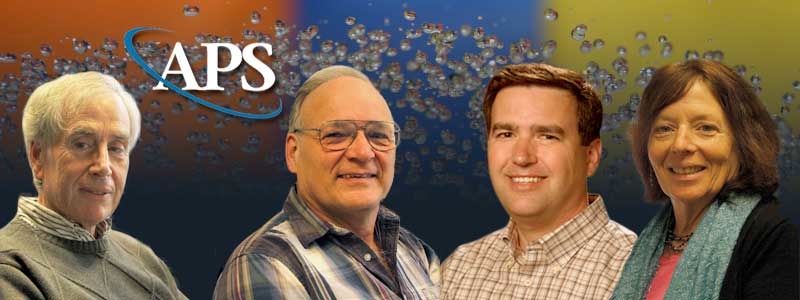Four Lawrence Livermore researchers named 2013 APS Fellows
 (Download Image)
Four Lawrence Livermore National Laboratory scientists have been selected as 2013 fellows of the American Physical Society (APS). They include, from left: Charles Cerjan, Ian Thompson, Eric Schwegler and Marilyn Schneider.
(Download Image)
Four Lawrence Livermore National Laboratory scientists have been selected as 2013 fellows of the American Physical Society (APS). They include, from left: Charles Cerjan, Ian Thompson, Eric Schwegler and Marilyn Schneider.
Physicist Charles Cerjan was cited by the Division of Atomic, Molecular and Optical Physics for "seminal contributions to time-dependent Schrodinger equation propagation algorithms and their application to particle scattering and intense field dynamics, the development of laser-produced plasma sources for advanced lithography and the investigation of the basic mechanism of magnetic multilayer material response and its application to magnetic storage devices."
Cerjan joined LLNL in 1983 and has contributed to soft-X-ray lithographic source development, magnetic materials for hard disk drive applications, intense laser field effects and, most recently, nuclear diagnostic analysis on the National Ignition Facility (NIF). His research interests include novel laser field effects, mathematical physics and developing effective numerical techniques. He received his bachelor's degrees in mathematics and chemistry from the University of Minnesota and a master's and Ph.D. in chemical physics from Harvard University.
"I have been associated with many diverse projects at LLNL, but one recurring theme has been the universally impressive expertise of the scientific and engineering personnel," Cerjan said. "It has been an honor and pleasure to count many of my co-workers as good friends. I look forward to more exciting research and fruitful collaborations across the broad range of Laboratory projects."
Marilyn Schneider, group leader for the Physics and Life Sciences (PLS) Directorate's Radiative Properties Group and the functional group leader for the Radiation Physics and Spectroscopic Diagnostics Group in the NIF High Energy Density (HED) Science and Technology Organization, was recognized for "outstanding contributions to X-ray measurements in laser-produced plasmas" by the Topical Group on Instrument and Measurement Science.
Schneider joined LLNL in 1986 and has been involved in a variety of areas for both the Defense Sciences and Inertial Confinement Fusion Programs, including basic atomic physics studies at the Electron Beam Ion Trap (EBIT), opacity measurements using high-power lasers, interface instability studies and the development of hot hohlraums and ignition-scale hohlraums. Her research interests include the science of interfaces, the physics of thermal X-radiation sources and radiation transport in HED plasmas. She received her bachelor's degree in physics from Barnard College, Columbia University and a master's and Ph.D. in physics from Cornell University.
"My thesis adviser, Watt W. Webb, greatly influenced me by setting a high standard of excellence for experimental work. I have tried hard to keep that standard and my colleagues here in PLS and at NIF have made that, if not easy, at least exciting and fun," Schneider said. "I feel honored to work with such creative, intelligent and dedicated people."
Eric Schwegler, group leader for Quantum Simulations in the Condensed Matter and Materials Division, was cited in the Division of Computational Physics for "important contributions to the development of linear scaling electronic structure theory, and the use of first-principles methods to examine the properties of aqueous solutions, nanomaterials and matter under extreme conditions." Schwegler received his Ph.D. in physical chemistry from the University of Minnesota, following undergraduate degrees in computer science and chemistry from Southwestern University. In 1998, he joined LLNL as a postdoctoral researcher, and in 2005 he was appointed as the Quantum Simulations group leader.
"I am quite honored to be selected as a fellow," Schwegler said. "I have benefitted greatly from all the people I have worked with and the environment and opportunities here at Lawrence Livermore have certainly had a tremendous impact on my career as a scientist."
Ian Thompson, theoretical nuclear physicist in the Nuclear Theory and Modeling group, was cited by the Division of Nuclear Physics for "the development and application of all-order treatments of nuclear-cluster dynamics in peripheral reactions; leading to a new understanding of halo nuclei within a few-body framework."
Thompson joined LLNL in 2006, after serving as professor of physics at the University of Surrey, England. He is a fellow of the U.K.'s Institute of Physics. He has been involved in the study of multistep inelastic, transfer and breakup reactions and how they connect to the production and decay of compound nucleus states. His textbook "Nuclear Reactions for Astrophysics" was published in 2009, and he contributed the chapter on Coulomb Functions to the new NIST Handbook of Mathematical Functions. He received a bachelor's degree in physics from the University of Auckland, New Zealand; a master's degree in computer science from Massey University, New Zealand; and a Ph.D. in theoretical nuclear physics from the University of Auckland.
"It has been an interesting challenge moving from a university to a laboratory environment when I came here in 2006," Thompson said. "But here there are good opportunities for applications, with more ambitious collaborations and larger-scale calculations."
The four researchers join two recognized earlier this year, for a total of six LLNL 2013 fellows. In the past 30 years, nearly 100 LLNL employees have been elected APS fellows.
APS fellowships are awarded after extensive review and are considered a distinct honor because the evaluation process, conducted by the fellowship committees of individual divisions, topical groups and forums, relies on nomination and recommendation by one's professional peers. Election to APS fellowship is limited to no more than one half of 1 percent of APS' membership for a given year.
Contact
 Breanna Bishop
Breanna Bishop
[email protected]
(925) 423-9802
Related Links
APSFellows
Tags
Physical and Life SciencesFeatured Articles







